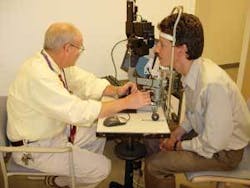CONFERENCE REVIEW: Photon Forum highlights optoelectronic opportunities

The next generation of technology and investment opportunities in the world of optoelectronics was the focus of Photon Forum 2006 (April 25 and 26; Cambridge, MA), cosponsored by Laser Focus World and Breault Research Organization (Tucson, AZ). The forum, whose purpose was to present important technological advances and trends taking place in the photonics and optics arena from a forward-looking perspective, gave technologists and product developers in the photonics industry a chance to mingle with investors, academic researchers, and media representatives, with talks given by top industry executives and academics.
In the first of three keynote addresses, Steve Eglash, a principal at venture-capital (VC) firm Worldview Technology Partners (Palo Alto, CA), presented an overview of VC funding in photonics, noted the many acquisitions of companies in the last year and a half, and predicted a return to growth for long-haul optical communications. His talk also encompassed solid-state lighting, photovoltaics, and displays, noting, for example, that photovoltaics had a banner year, with three initial public offerings last year.
Fred Leonberger, a senior advisor at the Massachusetts Institute of Technology’s Center for Integrated Photonic Systems (Cambridge, MA) delved into the technology and commercial potential of photonic integrated circuits, describing a number of components such as Inplane’s miniature on-chip erbium-doped waveguide amplifier, able to become an integral part of planar lightwave circuits; tunable laser technology developed by Agility (now part of JDSU; Milpitas, CA), and photonic-integrated-circuit architecture developed at Infinera (Sunnyvale, CA). These and other results point the way to more-pervasive photonics integration in the future.
Photonics virtual foundry
Michael Lebby, president of the Optoelectronics Industry Development Association (OIDA; Washington, D.C.) and the last keynote speaker, hewed close to the overall theme of the forum, covering the global market and technology trends in optoelectronics; he predicted that it will become a trillion-dollar business by 2015. Narrowing to the specific, he focused on blue-laser DVD technology, telecommunications, high-brightness light-emitting diodes (LEDs), fiber sensors, imaging, and nanophotonics, among others. He noted that the OIDA is planning to initiate a “photonics virtual foundry,” in which underused indium phosphide foundries will be united in a platform that will focus on lasers, modulators, and detectors, and that will eliminate proprietary constraints and improve supply reliability.Technology talks included one by Paul Hartung of Neuroptix (Acton, MA) on noninvasive early detection of Alzheimer’s disease by sensing the appearance of beta-amyloid protein in the lens of the patient’s eye through measurement of scattering of laser light (see figure); and a presentation by Bob Gelfond of MagiQ Technologies (New York, NY) on quantum private networks (QPNs), which are needed to counter the impending threat of, paradoxically, quantum computing-which, if realized, may be able to crack the best conventional encryption schemes. A photonic QPN has been developed with this capability, and which also counters conventional threats such as unauthorized tapping into optical fibers to gather data.
Jean-Michel Peleprat of Novalux (Sunnyvale, CA) outlined his company’s full-color TV projector based on Novalux’s vertical-cavity lasers. The TV has a thin form factor and will compete against plasma displays, said Peleprat. Paul Larson of Daylight Solutions (San Diego, CA) discussed the company’s new widely tunable quantum-cascade laser (see www.laserfocusworld.com/articles/252457), which makes it easier to acquire spectroscopic data in the mid-IR-the crucial region for detecting most common organic substances. Larson suggested application examples, including anesthesia, breath analysis, and glucose monitoring. David Zimdars of Picometrix talked about terahertz imaging for homeland security and nondestructive testing, such as that applied to the ceramic tiles used on the Space Shuttle.
A talk given by Michael Lebby (and guided by a presentation created by Larry Marshall of Intersymbol of Mountain View, CA, who couldn’t attend) covered silicon photonics; Lebby drew upon his own past experience in the silicon photonics group at Intel (Santa Clara, CA). The aim is to make entire optical systems chip-size and to combine them with electronics; however, as optical and optoelectronic elements get smaller, they interact more. Other problems appear; for example, computer chips heat up, causing lasers to underperform. One approach, then, is to remove at least the laser from the chip and pipe the light in.
Miniature spectroscopy
Petros Lotidis of Axsun Technologies (Billerica, MA) talked about his company’s spectroscopy-on-a-chip device, which shrinks the size of a spectral engine to matchbook size. The resulting instrument finds use in the pharmaceutical, petrochemical, and chemical-sensing industries. Anita Mahadevan-Jansen of Vanderbilt University (Nashville, TN) spoke about Raman spectroscopy and its use in the medical field, for example in finding the extent of brain tumors with ill-defined boundaries, and in the detection of skin cancer. In fact, Mahadevan-Jansen sees the eventual development of a handheld “Star Trek tricorder-like” Raman device that can be passed across the skin to find cancer.
A talk given by Robert Steele of Strategies Unlimited (Mountain View, CA) covered the prospects for solid-state lighting, which has enjoyed a compound annual growth rate from 1995 to 2005 of 42%, although growth has slowed since (see “High-brightness LED market cools after three years of stellar growth,” p. 57). While about half of all high-brightness LEDs are used in mobile appliances, other applications, such as illumination and displays, will see more future growth. Innovations such as color mixing of white light (see www.laserfocusworld.com/articles/255497) will aid this growth. Barbara Paldus, CEO of Finesse (Irvine, CA) described the use of photonics sensors for bioprocess measurement and control, in particular monitoring cell performance in bioreactors (used to make bioproducts or for research). Suzanne Arney of Lucent Technologies (Murray Hill, NJ) discussed the work in MEMS (microelectromechanical systems) that is going on at Lucent.

John Wallace | Senior Technical Editor (1998-2022)
John Wallace was with Laser Focus World for nearly 25 years, retiring in late June 2022. He obtained a bachelor's degree in mechanical engineering and physics at Rutgers University and a master's in optical engineering at the University of Rochester. Before becoming an editor, John worked as an engineer at RCA, Exxon, Eastman Kodak, and GCA Corporation.
